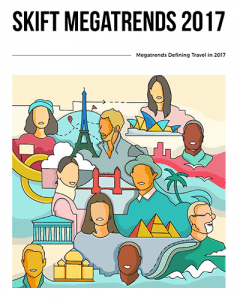Skift Take
The new standards of modern luxury are consumer-led rather than brand-driven, and they are steering the direction of high-end hospitality and travel.
Last month we released our annual travel industry trends forecast, Skift Megatrends 2017. You can read about each of the trends on Skift, or download a copy of our magazine here.
Download Your Copy of Skift Megatrends 2017
You may have noticed, over the last few years, a change in the wind — if not in your own luxury preferences and purchases, then surely with the tenor of a new generation of brands and services that all seem to embody a refreshingly modern take on what qualifies as luxurious.
You may have found yourself quietly questioning whether a mass-produced “luxury” carry-on, for instance, plastered with a monogram motif can qualify as luxurious, simply because of its high price. That’s especially true when you can find a competing product of equal or better quality — and at a better price — from an up-and-coming specialist.
Exclusivity — and delight — are still just as important for the modern luxury experience today as they’ve ever been. But rather than scarcity being tied up in the cost of an item, or prestige being defined by the logo on the side of someone’s bag, scarcity and prestige are linked to unique and outstanding brand experiences.
The recent release of Snap’s Spectacles is a perfect example. The product rollout is intended to delight and to build excitement. But it also offers up a new way of thinking about exclusivity: exclusivity by geography, rather than financial exclusivity.
Social media-friendly, share-worthy, global: The Spectacles, while not quite a modern luxury item, have certainly adopted modern luxury behaviors. In doing so, they’ve stoked excitement for a product whose prestige is separated solely from price, and whose purchasing experience is exciting (and speaks volumes about the Snap brand going forward). These are talking points the hospitality industry might be wise to pay attention to.
Marked by a dramatic embrace of digital, and the arrival of a new wave of modern luxury brands and services that emphasize delightful experiences — be they in travel or otherwise — we find ourselves at a point on the luxury timeline where choice is now in the hands of the consumer, and smaller brands now have a chance to not only survive, but thrive. Furthermore, they’ve conditioned shoppers and travelers alike (who are often one and the same) to expect certain behaviors from the luxury brands they support and at the properties around the world where they choose to stay. In doing so, these up-and-comers are guiding the direction of the luxury marketplace today.
The longstanding standards of decorum and good taste have been upturned:
“Opulence,” The Telegraph’s Stephen Bayley recently noted, “is a dated part of any definition of luxury.” Opulence, and opulence alone, doesn’t cut it in today’s competitive marketplace, which is driven by transparency and consumer choice/independence.
In the hospitality industry, we’ve already seen strategies that reflect this new way of luxury thinking from the likes of Conrad Hotels and Waldorf Astoria Hotels. Both have recently introduced new programs (Conrad’s “Smart Luxury” initiative and Waldorf’s “Unforgettable Experiences” program) intended to offer a more tailored experience for the well-heeled traveler. These programs are ambitious and certainly forward-looking, but they’re also both an indirect reaction to the thinking (and threat) of Airbnb as well as more contemporary high-end hostels and hotel chains where buzzwords like “personal,” “authentic,” and “local” weigh heavily.
This sort of thinking reflects a new philosophy, where consumers aren’t limited to the confines of a particular brand, and where companies simply become the catalyst by which they can create their own outcomes. That’s one of the reasons why consumers are flocking to products that hide their logos on the inside, thereby allowing shoppers to express their sense of style without it being defined by a particular logo, NPD Group reported. The retail research firm recently reported that a third of all handbag purchases over a 12-month period up to June 2016 were of bags that hid their logos or had none at all. This uptick was consistent across all age groups — both younger buyers and older ones — not just shoppers in their 20s.
As these examples demonstrate, today’s concept of luxury, whether for retail or for travel, isn’t what it used to be. It’s not about conspicuous consumption. It’s about the personal journey, the experience, and the story behind it all. And that, in and of itself, presents the hospitality industry with an incredible opportunity to deliver truly bespoke and memorable experiences for today’s discerning luxury traveler. Drawing on the expertise of retail innovators, smart luxury hoteliers can enhance the overall guest experience to be more personalized, more transparent, more desirable, and much more innovative than ever before.
Download Your Copy of Skift Megatrends 2017

The Daily Newsletter
Our daily coverage of the global travel industry. Written by editors and analysts from across Skift’s brands.
Have a confidential tip for Skift? Get in touch
Tags: megatrends 2017, retail

